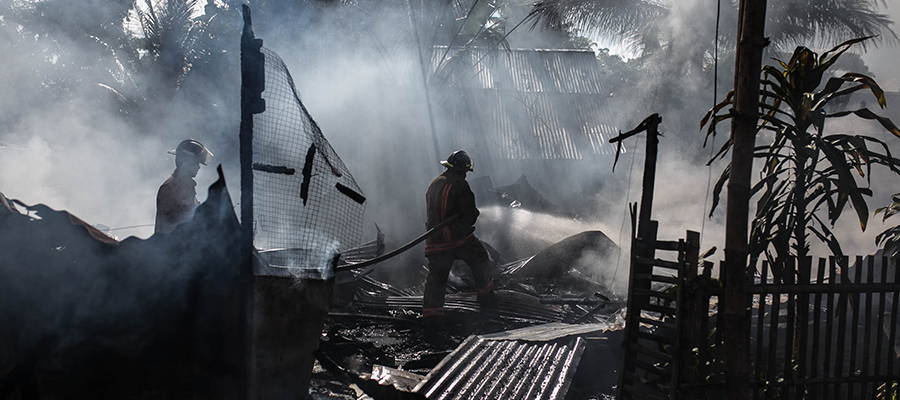With the swell of temperature across Europe, tropical storms rocking the Southeast, and earthquakes shaking up the West Coast, it is crucial to understand how to stay safe in the workplace and at home- especially during a disaster.
Natural disasters carry the most potential energy on the planet, but while we love to tout our own achievements and technological advances, we are still often humbled by a simple act of nature. For example, according to the Center for Earthquake Research and Information and the U.S. Geological Survey, a magnitude 9.0 earthquake is about equivalent to 25,000 nuclear bombs.
It only takes one tectonic shift to separate a fault line, or one storm to submerge a city. With a decade-long rebuilding effort required, Hurricane Katrina brought into stark focus just how devastating the impact of a natural phenomenon can have on a community.
As climate change becomes an increasingly hot topic, we’re feeling the effects even without a full-blown “disaster” occurring.
Thus, it is necessary to factor in the tangible consequences felt by people daily - particularly at work. While many people love soaking some rays in the summer months, heat is the single largest weather-related killer in the United States. Therefore, whether it is a natural disaster or simply the daily report, you shouldn’t wait until magnitude 10 to exhibit safe work practices.
Is your workplace prepared for a disaster?
While you can never truly prepare for a natural disaster, there are steps you can put in place in order to have the best possible chance of avoiding serious harm.
As a start, all businesses exceeding 10 employees must have a written plan for how to react to a natural disaster - one that’s kept up to date. Staff - particularly new employees - should be regularly briefed and trained on the plan in a language that they understand.
Information in the plan should include:
Evacuation and exit routes
Means of reporting the disaster
Emergency contacts and personnel
Nearby emergency centres
It’s important that you’re prepared for any disaster that’s likely to happen in your local area. Whether that be earthquakes, tornadoes, or hurricanes, an emergency response plan should be in place.
California has a long history of earthquakes, with the 1906 San Francisco serving as the paramount example. This massive quake caused widespread fire and damage totalling over $524 million changing the history and landscape of the famous city.
While today’s buildings and society may be more equipped to deal with such disasters, there are always precautions one can take.
The same principles apply at work as at home. If a tremor hits, drop down and take cover under a sturdy desk or table, and if possible, remain inside until the shaking stops.
What about industrial workplaces?
For those working in industrial roles, natural disasters can spell even more significant danger.
The Fukushima disaster in Japan, 2010, saw the devastating effects of an earthquake and subsequent tsunami, which shut down the nuclear plant’s cooling towersand caused a level 7 major incident.
As well as the initial damage caused by the tremor, this also brought into focus the way that a natural catastrophe can open the levies for secondary damage resulting in millions, if not billions in damage – air quality from the nuclear fallout was even affected as far as the Pacific Coast of the United States.
Depending on where you live (and work) damage from natural disasters are usually out of control but developing a disaster preparedness program can be a step towards a solid footing. Be sure to consult your EHS Professional to understand what to do when silt hits the fan!
Avoiding the ill effects of the climate
Not all hazards present themselves at the magnitude of a crisis. The crescendo of heat during the summer months can be received as a pleasant change of pace from the more frigid cycle of seasons, but often it comes with dire consequences as hot weather has more than one chemical effect on the brain.
Heatstroke can be very dangerous, and if not treated may cause damage to a range of organs including the brain, heart, and kidneys. Be aware of your employees’ health in hot weather, and look out for the symptoms of heatstroke- the longer they are ignored, the more severe the damage can be. Hydration is key!
The potential effects of heat stress and heatstroke can be devastating. In Suma, Washington, a farmworker died in 2017 after being told to return to work despite complaining of a headache in severe high temperatures. Justifiably, this led to protests from colleagues as the employer endangered this individual breaking OSHA’s general duty clause.
To avoid heat stress, indoor workers should be in well ventilated areas, ideally with air conditioning available to keep them cool.
Those working outside are advised to stay in the shade as much as possible and use cooling pads to regulate temperature - which is particularly important for people wearing PPE such as hard hats or harnesses.
Stay safe at work and at home
What do you do when the hazard comes from above (or below)? While the onus for safety rests with both the employee and employer, it should not take a meltdown to be aware of the natural hazards of the workplace and the controls in place to mitigate them – be sure to ask about your Emergency Response plan at the next safety meeting. With these tips and a disaster preparedness program in place, more lives can escape the dog days of summer and return to their families after a long, hot day of work.
